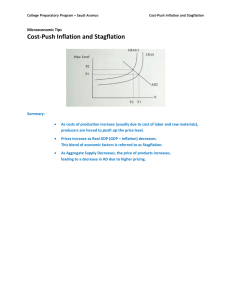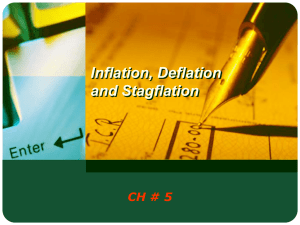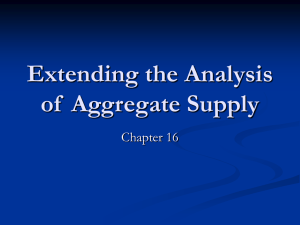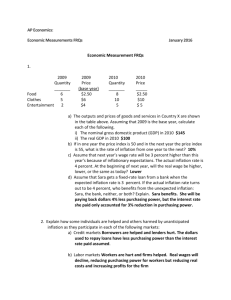4291 (9) Stagflation - The Bichler and Nitzan Archives
advertisement
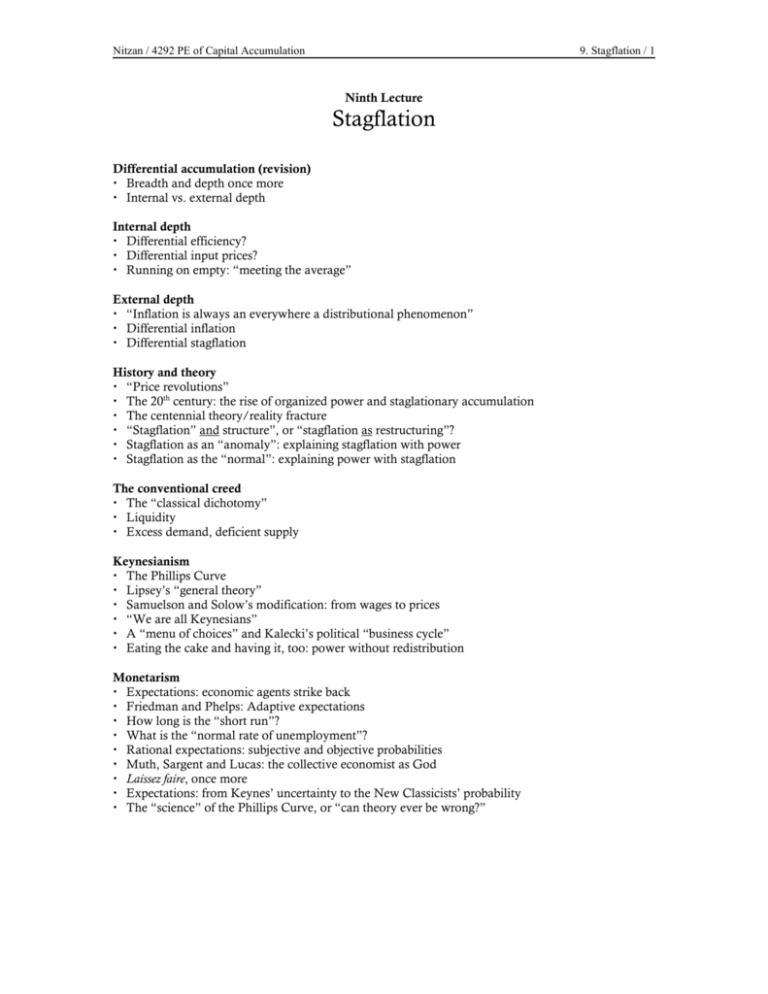
Nitzan / 4292 PE of Capital Accumulation 9. Stagflation / 1 Ninth Lecture Stagflation Differential accumulation (revision) Breadth and depth once more Internal vs. external depth Internal depth Differential efficiency? Differential input prices? Running on empty: “meeting the average” External depth “Inflation is always an everywhere a distributional phenomenon” Differential inflation Differential stagflation History and theory “Price revolutions” The 20th century: the rise of organized power and staglationary accumulation The centennial theory/reality fracture “Stagflation” and structure”, or “stagflation as restructuring”? Stagflation as an “anomaly”: explaining stagflation with power Stagflation as the “normal”: explaining power with stagflation The conventional creed The “classical dichotomy” Liquidity Excess demand, deficient supply Keynesianism The Phillips Curve Lipsey’s “general theory” Samuelson and Solow’s modification: from wages to prices “We are all Keynesians” A “menu of choices” and Kalecki’s political “business cycle” Eating the cake and having it, too: power without redistribution Monetarism Expectations: economic agents strike back Friedman and Phelps: Adaptive expectations How long is the “short run”? What is the “normal rate of unemployment”? Rational expectations: subjective and objective probabilities Muth, Sargent and Lucas: the collective economist as God Laissez faire, once more Expectations: from Keynes’ uncertainty to the New Classicists’ probability The “science” of the Phillips Curve, or “can theory ever be wrong?” Nitzan / 4292 PE of Capital Accumulation Supply shocks Stagflation: an upward slopping Phillips Curve? The postmodern “other”: blame it on the oil sheiks, the weather and the workers Oil sheiks and the whether: do raw material prices cause inflation? Do workers cause inflation? “Wage push” or “profit push”? “Markup inflation” and “barriers to entry” Inflation and redistribution Barking up the wrong tree Inflation as restructuring Where is politics? Redistribution: capitalists contra workers Redistribution: large vs. small firms Why stagflation – “return” and “risk” Regimes of differential accumulation The pendulum of breadth and depth 9. Stagflation / 2 Nitzan / 4292 PE of Capital Accumulation 9. Stagflation / 3 Differential Earnings earningsD employoment D earnings per employeesD Table 1 Regimes of Differential Accumulation External Internal Breadth Green-field Mergers & Acquisitions Depth Stagflation Cost-cutting 1,000.0 log scale 1999 218% 100.0 trend growth rate: 3.4% per annum 10.0 1.0 Buy-to-Build Indicator (mergers & acquisitions as a per cent of gross fixed private domestic investment) 1896 0.3% www.bnarchives.net 0.1 1880 FIGURE 1 1900 1920 1940 1960 1980 2000 2020 U.S. Accumulation: Internal vs. External Breadth NOTE: Indicator is based on splicing of separate series. SOURCE: Jonathan Nitzan and Shimshon Bichler, Capital as Power. A Study of Order and Creorder (New York and London, Routledge, 2009), Ch. 15, Data Appendix. Nitzan / 4292 PE of Capital Accumulation 9. Stagflation / 4 “Running on empty” “How do you build a company, when your buyers are infinitely knowledgeable and where your suppliers maintain a level playing field for your competitors? What remains your competitive differentiator or your source of value or whatever academic cliché you want to wrap around it?” Andrew Grove, Chairman of Intel. Cited in Byrne, John A. 2000. Visionary vs. Visionary. Business Week, August 28, pp. 210-212. 10,000 log scale Price increase from 1900 to 2010: 6,121% 1,000 Price increase from 1300 to 1900: 769% 100 1900 10 www.bnarchives.net 1 1200 FIGURE 2 1300 1400 1500 1600 1700 1800 1900 2000 2100 Consumer Prices in the U.K. SOURCE: Updated from Jonathan Nitzan and Shimshon Bichler, Capital as Power: A Study of Order and Creorder (New York and London: Routledge, 2009), Figure 16.1 p. 367. Original data from Global Financial Data (series code: CPGBRM) (Historical data from David Hackett Fischer. 1996. The Great Wave. Price Revolution and the Rhythm of History. New York and Oxford: Oxford University Press); IMF International Financial Statistics through Global Insight (series code: L64@C12). Nitzan / 4292 PE of Capital Accumulation FIGURE 3 9. Stagflation / 5 The Seeds of Differential Stagflation SOURCE: Means, Gardiner C. 1935. Price Inflexibility and Requirements of a Stabilizing Monetary Policy. Journal of the American Statistical Association 30 (190, June): 401-413. Nitzan / 4292 PE of Capital Accumulation 9. Stagflation / 6 . IMPLICIT GDP DEFLATOR (annual % change) 8 ` 6 4 2010 2 0 -2 -4 www.bnarchivs.net -6 -1 0 1 2 3 4 5 6 7 8 9 GDP IN CONSTANT PRICES (annual % change) FIGURE 4 United States: Inflation and Growth, 1809-2010 NOTE: Series are shown as 20-year moving averages. The straight line running through the observations is drawn free hand for illustration purposes. SOURCE: Updated from Jonathan Nitzan and Shimshon Bichler, Capital as Power: A Study of Order and Creorder (New York and London: Routledge, 2009), Figure 16.4 p. 377. Historical data till 1928 are from Global Financial Data (series code: GDPUSAM for GDP). From 1929 onward, data are from the U.S. Department of Commerce through Global Insight (series codes: GDP for GDP; PDIGDP for the implicit GDP deflator). Nitzan / 4292 PE of Capital Accumulation 9. Stagflation / 7 1,000 log scale Prices* (Annual % Change) 1984 100 1956 10 1967 1972 2000 1 0 2 4 6 8 10 Real GDP (Annual % Change) FIGURE 5 Israel: Long-Term Inflation and Growth NOTE: Series are shown as 5-year moving averages. SOURCE: Israel Central Bureau of Statistics. 12 14 Nitzan / 4292 PE of Capital Accumulation 9. Stagflation / 8 The neutrality of money “There cannot, in short, be intrinsically a more insignificant thing, in the economy of society, than money.” John Stuart Mill “Money is a veil.” Irving Fisher “Money is neutral, a veil with no consequences for real economic magnitudes.”. Franco Modigliani “Inflation is always an everywhere a monetary phenomenon.” Milton Friedman Nitzan / 4292 PE of Capital Accumulation 9. Stagflation / 9 The quantity theory of money [P = prices, T = transactions, M = money, V = velocity, Q = output; lower case variables represent rates of change] 1. P * T ≡ M * V 2. P ≡ M * V / T 3. p ≈ m + v – t 4. p ≈ m – t ;v=0 5. p ≈ m – q ;t=q 12 12 percent percent 10 10 8 GDP Deflator (annual % change) +25% GDP Deflator (annual % change) 8 6 6 4 4 2 2 0 0 -2 -2 -4 -6 bnarchives.net -6 1950 1960 1970 FIGURE 6 1980 1990 Liquidity M1 / Real GDP (annual % change) -4 Liquidity Monetary Base / Real GDP (annual % change) 2000 2010 2020 bnarchives.net -8 1950 1960 1970 1980 United States: Liquidity and inflation NOTE: Annual data smoothed as 5-year moving averages. Last data points are for 2010. SOURCE: IMF. 1990 2000 2010 2020 Nitzan / 4292 PE of Capital Accumulation FIGURE 7 9. Stagflation / 10 The Phillips Curve SOURCE: Phillips, A. W. 1958. The Relation Between Unemployment and the Rate of Change of Money Wages in the United Kingdom, 1861-1957. Economica New Series 25 (100, November): 283299 Nitzan / 4292 PE of Capital Accumulation 9. Stagflation / 11 From wage inflation to price inflation W is the wage rate, U is the rate of unemployment, P is the price level, Q is output per worker (labour productivity), K is the markup, and lower-case variables denote corresponding rates of change. 1. w f U 2. P 1 K W Q 3. p 1 K w q If the markup is fixed, we have, 4. w p q Substituting into equation 1: 5. p f U q Wage Inflation (w ) and Price Inflation (p ) (%) 30 20 10 w = f (U ) q 0 q p = f (U ) - q -10 0 2 4 6 8 10 12 14 16 18 20 22 24 26 28 30 32 34 36 38 40 Unemployment (%) Cost push and the end of perfect competition “Some holders of this view [cost push] attribute the push to wage boosts engineered unilaterally by strong unions. But others give as much or more weight to the co-operative action of all sellers –organized and unorganized labor, semimonopolistic managements, oligopolistic sellers in imperfect commodity markets – who raise prices and costs in an attempt by each to maintain or raise his share of national income, and who among themselves, by trying to get more than 100 per cent of the available output, create ‘seller’s inflation . . . to explain possible cost-push inflation, it would seem more economical from the very beginning to recognize that imperfect competition is the essence of the problem and drop the perfect competition assumptions.” Samuelson, Paul A., and Robert M. Solow. 1960. Problem of Achieving and Maintaining a Stable Price Level: Analytical Aspects of Anti-Inflation Policy. The American Economic Review 50 (2. May): 177-194 Nitzan / 4292 PE of Capital Accumulation 9. Stagflation / 12 “Expectations Augmented Phillips Curve” pt f1 U t pte pte f 2 pt 30 Long-Run Phillips Curve Price Inflation (%) 20 10 0 Natural rate of unemployment -10 0 2 4 6 8 10 12 14 16 18 20 22 24 26 Unemployment (%) 28 30 32 34 36 38 40 Nitzan / 4292 PE of Capital Accumulation 9. Stagflation / 13 Rational Expectations “. . . expectations of firms (or, more generally, the subjective probability distribution of outcomes) tend to be distributed, for the same information set, about the prediction of the theory (or the ‘objective’ probability distributions of outcomes).” Muth, John F. 1961. Rational Expectations and the Theory of Price Movements. Econometrica 29 (3, July): 315-335. “. . . expectations of inflation are assumed to be endogenous to the system in a very particular way: they are assumed to be ‘rational’ in Muth’s sense – which is to say that the public’s expectations are not systematically worse that the predictions of economic models. This amounts to supposing that the public expectations depend, in the proper way, on the things that economic theory says they ought to.” Sargent, Thomas J. 1973. Rational Expectations, the Real Rate of Interest, and the Natural Rate of Unemployment. Brookings Papers on Economic Activity (2): 429-472. pte E pt I t 1 pt E pt I t 1 u t pt pte u t Nitzan / 4292 PE of Capital Accumulation 9. Stagflation / 14 General Government Final Consumption Expenditure (% of GDP) 24 22 20 18 High Income Countries 16 14 12 10 8 Low and Middle Income Countries 6 4 2 0 1950 1955 1960 1965 1970 1975 1980 1985 1990 1995 2000 2005 2010 2015 NOTE: Cutoff point between Middle and High Income countries: $12,276 Gross National Income per Capita in 2010 (using the World Bank Atlas Method). (http://siteresources.worldbank.org/DATASTATISTICS/Resources/CLASS.XLS) SOURCE: World Development Indicators 2011 Price Inflation (%) Nitzan / 4292 PE of Capital Accumulation 9. Stagflation / 15 Original Phillips Curve? ` Price Inflation (%) Unemployment (%) Adaptive Expectations? ` Price Inflation (%) Unemployment (%) Rational Expectations? ` Unemployment (%) Nitzan / 4292 PE of Capital Accumulation 9. Stagflation / 16 Supply Shocks: The Usual Suspects “A clear and central villain of the piece is the historically unprecedented rise in commodity prices (mainly food and oil) in 1973-74 and again in 1979-80 that not coincidentally accompanied the two great burst of stagflation. “. . . one of the variables that set the stage for the 1970s stagflation was the rise in union power and militancy at the end of the 1960s. . . . A real wage boom resulted, which started a squeeze on profits even before 1973. . . . It strikes us as misguided to consider the labor market as a perfectly competitive bourse when in almost every OECD economy much of the labor force is unionized and governments play an enormous role in affecting labour compensation.” Bruno, Michael, and Jeffrey Sachs. 1985. Economics of Worldwide Stagflation. Cambridge, Mass.: Harvard University Press, p. 7 Supply Shocks: The Cruel Dilemmas “The limited capability of policy to influence supply poses a particularly vexing problem in a stagflationary world since any stabilization policy adopted in response to stagflation is bound to aggravate one of the problems [inflation or unemployment] even as it helps cure the other. Such is the policy dilemma of stagflation.” Blinder, Alan S. 1979. Economic Policy and the Great Stagflation. New York: Academic Press, pp 20-21. Nitzan / 4292 PE of Capital Accumulation 9. Stagflation / 17 100,000 index log scale CPI 10,000 Crude Pretroleum 1,000 Food 1957=100 100 bnarchives.net 10 1950 FIGURE 8 1960 1970 1980 1990 2000 2010 2020 World prices SOURCE: Jonathan Nitzan and Shimshon Bichler, The Global Political Economy of Israel (London: Pluto Press, 2002), Figure 4.9, p. 164. Original data are from IMF International Financial Statistics through Global Insight (series codes: L64@C001 for the CPI; L76AA&D@C001 for crude petroleum; L76EX&D@C001 for food). The last data points are for 2010. Nitzan / 4292 PE of Capital Accumulation 9. Stagflation / 18 10 8 80 GDP Deflator (annual % change, left) 75 6 4 70 2 65 0 Compesnation of Employees / Net National Income at Factor Cost (% right) -2 60 -4 -6 1930 FIGURE 9 1940 1950 1960 1970 1980 1990 2000 2010 Inflation and the Wage Share in the United States SOURCE: U.S. Bureau of Economic Analysis. Last data points are for 2010. 55 2020 Nitzan / 4292 PE of Capital Accumulation 9. Stagflation / 19 45 1,000 log scale GDP Deflator (annual % change, right) 40 Gross Wages / GDP (%, left) 100 35 30 10 25 Net Wages / GDP (%, left) 20 1960 FIGURE 10 1965 1970 1975 1980 1985 1990 1995 2000 1 2005 Inflation and the Wage Share in Israel SOURCE: Jonathan Nitzan and Shimshon Bichler, The Global Political Economy of Israel (London: Pluto Press, 2002), Figure 4.7, p. 157. Original data from Bank of Israel. Israel Central Bureau of Statistics Nitzan / 4292 PE of Capital Accumulation 9. Stagflation / 20 Wage push or profit push? Price = Unit Wage + Unit Profit P=W+∏ P = (1+K) * W where K = ∏/W “Wage push” inflation can occur only if K is fixed. If K is fixed, the rates of change of profit and of wages are the same. If the two rates of change are the same, “wage push” inflation must also be “profit push” inflation. Nitzan / 4292 PE of Capital Accumulation 9. Stagflation / 21 5.0 35 Corporate Earnings per Share / Wage Rate* (Index, right) 30 4.5 4.0 25 3.5 20 1985 1995 2005 2015 15 3.0 10 2.5 5 2.0 0 1.5 Wholesale Price Index (annual % change, left) -5 1.0 www.bnarchives.net -10 1940 FIGURE 11 1950 1960 1970 1980 1990 2000 2010 0.5 2020 U.S. Inflation and Capital-Labour Redistribution * Corporate earnings per share are for the S&P 500. The wage rate is the average hourly earnings in the goods producing private sector till 1963 and in the private sector afterwards. NOTE: Series are expressed as 3-years moving averages. Last data points are for 2011. SOURCE: Updated from Jonathan Nitzan and Shimshon Bichler, Capital as Power: A Study of Order and Creorder (New York and London: Routledge, 2009), Figure 16.2 p. 371. Original data from Standard & Poor’s through Global Insight (series code: EARN500NS for S&P 500 earnings per share); U.S. Department of Commerce and U.S. Bureau of Labor Statistics through Global Insight (series codes: AHPGP and AHPEAP for the wage rate; WPINS for the wholesale price index). Nitzan / 4292 PE of Capital Accumulation 9. Stagflation / 22 4. U.S. Inflation, Profits and Wages (annual % change, left) (index, right) www.bnarchives.net SOURCE: IMF: L64@C111 (consumer prices), L65EY@C111 (hourly wage); Compustat: I0010 (S&P 500 Composite). FIGURE 12 U.S. Inflation and Capital-Labour Redistribution SOURCE: Nitzan, Jonathan, and Shimshon Bichler. 2006. Cheap Wars. Tikkun, August, 9. Nitzan / 4292 PE of Capital Accumulation 9. Stagflation / 23 25 4.0 Wholesale Price Index (annual % change, left) 20 3.5 3.0 15 2.5 2008 10 2.0 5 2005 1.5 0 1.0 -5 0.5 Differential Markup: Fortune 500 / Business Sector * (right) -10 0.0 www.bnarchives.net -15 1950 FIGURE 13 1960 1970 1980 1990 2000 2010 -0.5 2020 U.S. Inflation and Differential Accumulation * The markup is the per cent of net profit in sales. The Fortune 500 markup is the per cent of after tax profit in sales revenues. The business sector markup is computed by dividing total corporate profit after tax with IVA and CCA (from the national income accounts) by total business receipts (from the IRS). The Differential Markup is given by dividing the Fortune 500 markup by the business sector markup. NOTE: Until 1993, the Fortune 500 list included only industrial corporations (firms deriving at least half their sales revenues from manufacturing or mining). From 1994 onward, the list includes all corporations. For 1992-3, data for Fortune 500 companies are reported without SFAS 106 special charges. SOURCE: Jonathan Nitzan and Shimshon Bichler, Capital as Power: A Study of Order and Creorder (New York and London: Routledge, 2009), Figure 16.3 p. 373. Original data from the U.S. Department of Commerce through Global Insight (series codes: ZAECON for total corporate profit after tax with IVA and CCA; WPINS for the wholesale price index); U.S. Internal Revenue Service; Fortune. Nitzan / 4292 PE of Capital Accumulation FIGURE 14 9. Stagflation / 24 Stagflation Index NOTE: Stagflation Index = (standardized inflation – standardized growth) / 2. Series are measured as 12-month % change and shown as 3-year moving averages. SOURCE: IMF (codes: L64_A_C110 for CPI; L66_N_I_A_C110 for Industrial Production). Nitzan / 4292 PE of Capital Accumulation 9. Stagflation / 25 2 10,000.0 log scale Stagflation Index * (Unemployment plus Inflation, right) 1 1,000.0 0 2007 2007 100.0 -1 -2 10.0 -3 1.0 Amalgamation Index ** (Buy-to-Build Indicator, left) -4 www.bnarchives.net 0.1 1880 FIGURE 15 1900 1920 1940 1960 1980 2000 2020 -5 2040 Amalgamation and Stagflation in the U.S.A. * Computed as the average of: (1) the standardised deviations from the average rate of unemployment; and (2) the standardized deviation from the average rate of inflation of the GDP implicit price deflator. ** Mergers and acquisitions expressed as a per cent of gross fixed private domestic investment. NOTE: Series are shown as 5-year moving averages (the first four observations in each series cover data to that point only). SOURCE: Jonathan Nitzan and Shimshon Bichler, Capital as Power: A Study of Order and Creorder (New York and London: Routledge, 2009), Figure 17.1 p. 384. The stagflation index is computed based on data from the U.S. Department of Commerce through Global Insight (series codes: RUC for the rate of unemployment since 1929; PDIGDP for the GDP implicit price deflator); Historical Statistics of the United States (series D-8, p. 126 for the rate of unemployment before 1929). For details on the Amalgamation Index, see the Appendix to Chapter 15 in Nitzan and Bichler, Capital as Power. A Study of Order and Creorder.
